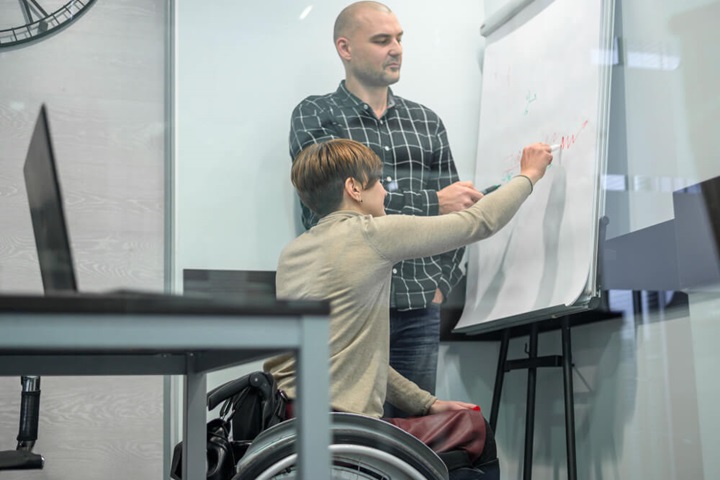Adaptive teaching is a revolutionary method within personalised learning methods. This dynamic approach allows experts within the education system to meet the unique needs of every student.
Despite its recent popularisation, adaptive teaching has roots stretching back decades, helping how educators respond to different classroom learning methods. In this article, we will explore the essence of adaptive teaching, contrast it with traditional differentiation techniques, and provide practical strategies for implementation. Discover the significant benefits and challenges it poses in modern educational settings, ensuring inclusivity and maximising student potential across various sectors and academic locations.
Key points:
- Understand the fundamentals of adaptive teaching and its historical context.
- Learn the differences between adaptive teaching and differentiation.
- Explore practical strategies for implementing adaptive teaching in your classroom.
- Examine the benefits and potential challenges of adaptive teaching.
- Gain insights on how adaptive teaching can transform educational outcomes for all students.
- What is Adaptive Teaching?
- Adaptive Teaching vs Differentiation
- Why Adaptive Teaching Matters:
- Strategies for Effective Adaptive Teaching
- Benefits of Adaptive Teaching
- Benefits to Educators
- Correlation with Improved Performance
- Creating an Inclusive Learning Environment
- Who Benefits Most from Adaptive Teaching?
- Adaptive Teaching Tips for Effective Instruction
- Before the Lesson
- During the Lesson
- After the Lesson
- Useful Tools for Adaptive Teaching
- Challenges of Adaptive Teaching
- Incorporating Adaptive Teaching in Online Learning
- FAQs
- Sources
What is Adaptive Teaching?
Adaptive teaching is an educational approach that offers bespoke learning experiences to the needs of individual students. This method, which some may consider to be a new contemporary method, actually traces back to research conducted in 1986 by Giyoo Hatano and Kayoko Inagaki, who explored adaptive practices in the classroom. At its core, adaptive teaching involves adjusting teaching strategies, tools, and approaches based on the ongoing assessment of student understanding and needs.
Adaptive teaching strategies often include re-teaching misunderstood content, using flexible groupings, and continuously responding to how students learn. This personalised approach not only supports various learning styles but also promotes an inclusive environment that caters to all students.
Adaptive Teaching vs Differentiation
While both adaptive teaching and differentiation aim to cater to different learning needs, they differ significantly in execution and philosophy. Differentiation typically involves providing students with varied types of content, processes, and products expected based on their presumed capabilities. This approach often restricts lower-ability learners to simpler tasks, potentially capping their learning progress.
Conversely, adaptive teaching does not limit students by pre-assigned levels. Instead, it provides a structure that supports all students to achieve the same learning objectives. This method fosters a more inclusive classroom setting where support is provided based on actual needs rather than assumptions based on ability or labels, such as Special Educational Needs and Disabilities (SEND) or autism.
Why Adaptive Teaching Matters

Adaptive teaching distinguishes itself from traditional differentiation by focusing on the underlying reasons behind a student’s struggle rather than just addressing the symptoms. This approach ensures that all students have the opportunity to achieve the best possible outcomes.
Strategies for Effective Adaptive Teaching
- Creating an Inclusive Environment: The classroom should be a welcoming space where all students feel valued. This atmosphere is crucial for the success of adaptive teaching.
- Curriculum Planning: Effective curriculum design incorporates methods for various learning barriers and ensures that content is accessible to all students. Planning must be flexible to adapt to the needs identified during classroom interactions.
- Challenging Yet Accessible: Contrary to common beliefs, the challenge level in adaptive teaching isn’t diminished; it’s appropriately adjusted to meet the needs of all learners without compromising the depth of learning.
- Formative Assessment: Regular and strategic questioning helps teachers adapt their teaching in real-time, based on how students respond during lessons.
Examples of Adaptive Teaching in Action:
- Rewording content and questions for clarity.
- Adapting language to ensure comprehension across all learners.
- Demonstrating ‘What A Good One Looks Like’ (WAGOLLs) with detailed breakdowns to guide understanding.
- Highlighting key points through bolding or alternative visibility enhancements.
- Utilizing keyword prompts to reinforce critical information.
- Implementing flexible and temporary group structures to support targeted learning needs.
- Simplifying instructions into clear, sequential steps.
- Providing feedback that is both rigorous and precise, allowing sufficient time for student reflection and action.
Benefits of Adaptive Teaching

Adaptive teaching not only elevates how educators approach individual student needs but also provides significant benefits across educational environments. Here are some of the key benefits that both teachers and students can undertake from adaptive teaching routines:
- Student Engagement
One of the foremost benefits of adaptive teaching is the increased engagement of students. By tailoring the learning experience to individual needs, students become more invested and motivated. This personalised approach ensures that learners are neither under-challenged nor overwhelmed, keeping their interest and attention high.
- Improving Learning
Adaptive teaching methods are designed to support each student uniquely, leading to better comprehension and retention of information. As a result, students achieve higher levels of academic performance. This approach allows educators to build on each student’s strengths and address their weaknesses effectively, promoting a deeper understanding and mastery of the subject matter.
- Supporting Different Learning Groups
Adaptive teaching recognises and respects the varied abilities and backgrounds of all students without making assumptions about their capacities. This method provides necessary support only when needed, avoiding the pitfall of setting lower expectations for certain groups, which often occurs in traditional differentiation strategies.
- Fostering Autonomy
In an adaptive teaching environment, students have greater control over their learning processes. This autonomy encourages them to take on challenges at their own pace and according to their ability, without being confined by predetermined expectations or categories.
Benefits to Educators
For teachers, adaptive teaching simplifies planning by allowing them to prepare one comprehensive lesson that adapts in real-time to suit all students’ needs. This efficiency not only saves time but also helps the teacher’s ability to assess and understand each student’s grasp of the content, leading to more effective teaching.
Correlation with Improved Performance
Research, including studies by PISA, indicates that adaptive instruction correlates strongly with superior educational outcomes. This relationship highlights the effectiveness of responsive teaching strategies in enhancing student performance.
Creating an Inclusive Learning Environment
With every student engaged in the same activities, adaptive teaching eliminates the visible distinctions between different groups of learners that traditional methods often create. This inclusivity helps build a more supportive and unified classroom culture.
Who Benefits Most from Adaptive Teaching?
While adaptive teaching is beneficial for all students, it is particularly advantageous for those with unique educational needs.
- Students with Disabilities or Learning Differences: This approach allows for modifications such as extended time, tailored questioning, and the use of specific resources, enabling these students to participate fully and effectively in lessons.
- Students with English as an Additional Language (EAL): Adaptive strategies, such as bilingual instruction and the use of visual aids, help EAL students understand and keep up with their peers.
- Higher Attainers: These students can be continually challenged at their own pace, ensuring they remain engaged and are not held back by a standardised curriculum.
- Pupil Premium (PP) Students: Often from lower socio-economic backgrounds, these students can achieve the same high standards as their peers, with additional support provided as needed.
Delve into our detailed exploration of what is classroom management to optimise your learning environment to its full potential.
Adaptive Teaching Tips for Effective Instruction
Implementing adaptive teaching methods can seem daunting, but with the right strategies and tools, it can become a seamless part of everyday teaching. Here are practical tips to integrate them across different stages of a lesson.
Before the Lesson
- Know Your Learners: Understanding each student’s background, including their prior knowledge and specific needs (such as SEND or EAL), is crucial towards making progress sooner, for both teacher and learner. Use data from assessments and classwork to get a comprehensive view of your students’ abilities and requirements.
- Predict Barriers: Identify potential obstacles that could hinder learning, such as specialised vocabulary or common misconceptions. Prepare appropriate resources like texts, PowerPoint presentations, or worksheets tailored to address these challenges.
During the Lesson
- Formative Assessments: Employ techniques like diagnostic questions, mini-whiteboards, or low-stakes tests to gauge understanding in real-time. This immediate feedback will indicate when and where adaptations are necessary.
- Make In-the-Moment Adaptations: Adapt teaching strategies on the fly—whether it’s reading a text aloud, using visuals like diagrams, or employing analogies that resonate with the students.
- Responsive Teaching: Always be ready to adjust your approach based on students’ feedback and interactions during the lesson. This responsiveness ensures that all students remain engaged and supported throughout the class.
After the Lesson
- Reflect on Outcomes: Assess whether all students have achieved the learning objectives and identify those who may need further support or those who could be challenged more in the next lessons.
- Continuous Improvement: Use the insights gained from each lesson to refine future teaching practices, ensuring ongoing adaptation to meet students’ evolving needs.
Useful Tools for Adaptive Teaching
Several tools can facilitate adaptive teaching without adding to the teacher’s workload. Incorporate these into your lessons to help students with different learning styles to maximise their potential:
- Mini-Whiteboards
- Visualisers
- Graphic Organisers
- Teaching Assistants
- Word Banks
Challenges of Adaptive Teaching

Adaptive teaching, while innovative, presents several unique challenges that educators must recognise.
- Time: Despite being more dynamic and targeted than traditional differentiation methods, adaptive teaching requires considerable time to effectively plan and implement support. This challenge is amplified in larger classes, where individual attention becomes more complex to manage.
- Technological Limitations: The integration of technology, such as visualisers, plays a vital role in demonstrating concepts effectively under the adaptive teaching model. However, these tools often involve significant costs, and budget constraints can limit access. Similarly, the availability of key resources like teaching assistants, crucial for providing additional support, is not always guaranteed due to financial and staffing limitations.
- Assessment: Adaptive teaching also impacts how students are assessed. Students accustomed to receiving specific support may find traditional exams challenging if the same level of individualisation isn’t possible during assessments.
Unsure if teaching is right for you? Learn about other paths to consider in our discussion about career change for teachers.
Incorporating Adaptive Teaching in Online Learning
At NCC Home Learning, we understand the complexities and challenges of adaptive teaching. That’s why our online teaching courses are designed not just to instruct but also to equip educators with practical strategies for overcoming these hurdles.
Furthermore, for those looking to specialise further, our teaching assistant courses online provide additional resources and training. These courses are developed to support teaching assistants in becoming integral components of the adaptive teaching framework, ensuring that every classroom can cater to the unique needs of all students.
FAQs
How does adaptive teaching benefit students with disabilities?
Adaptive teaching is particularly beneficial for students with disabilities as it allows for modifications and accommodations that can help overcome learning barriers. Customisable content, pacing, and differentiated instruction help ensure that these students receive an education that is accessible and appropriate to their needs.
Can adaptive teaching be applied in large classrooms?
Yes, adaptive teaching can be applied in large classrooms, although it may require more planning and resource allocation. Utilising technology to segment students into smaller groups based on ability or interest, and employing teacher assistants or peer tutoring strategies can make adaptation more manageable.
Sources
GOV.UK. (2012) Children with special educational needs and disabilities (SEND). [online] Available at: https://www.gov.uk/children-with-special-educational-needs [accessed 04/12/2024]
Programme for International Student Assessment (PISA). (2024) Homepage. [online] Available at: https://www.oecd.org/en/about/programmes/pisa.html [accessed 04/12/2024]
Twinkl. (n.d.) What is EAL (English as an Additional Language)? [online] Available at: https://www.twinkl.co.uk/teaching-wiki/eal-english-as-an-additional-language [accessed 04/12/2024]








